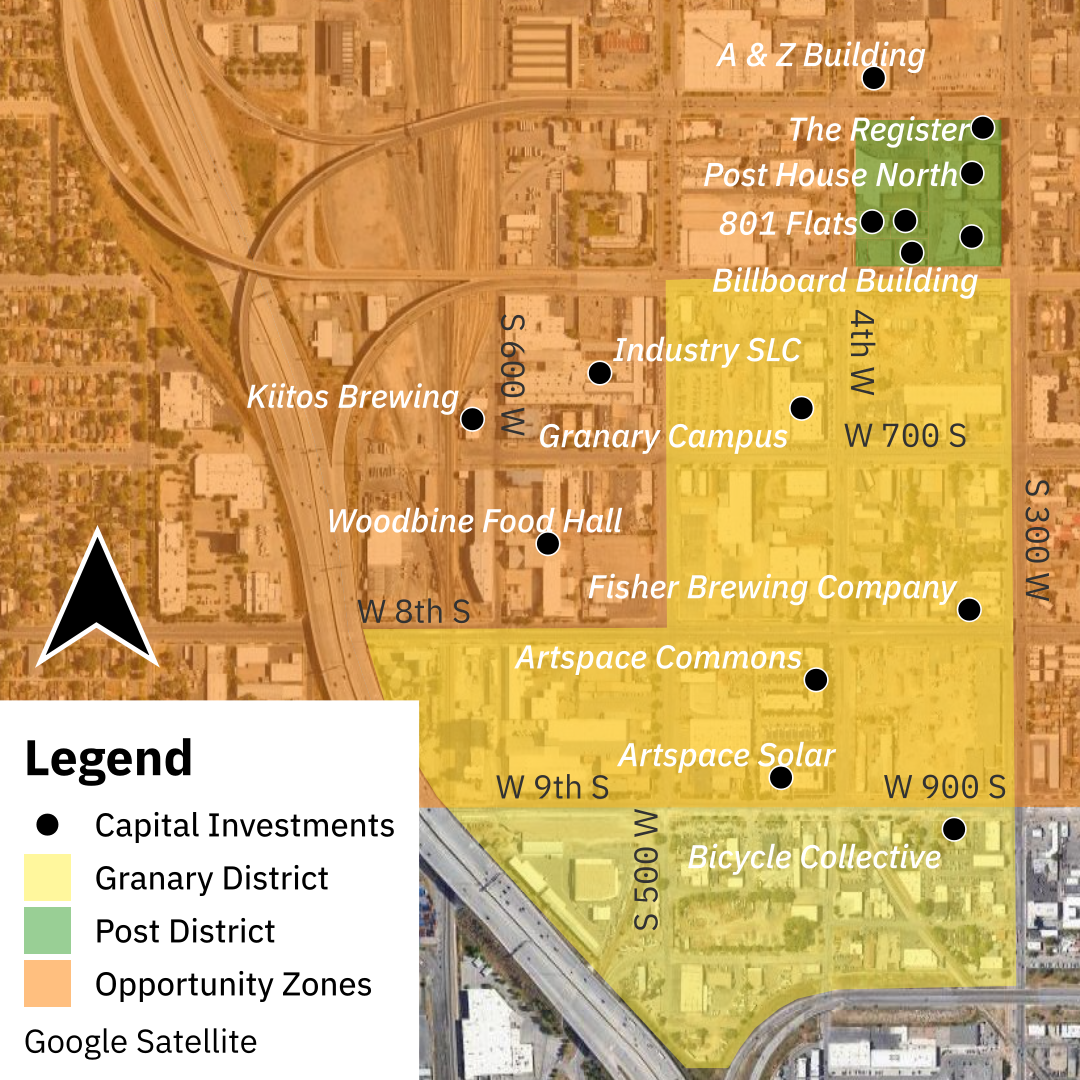
Just outside of downtown Salt Lake City lies a transitional space between several historically working class neighborhoods to the east and a vast industrial area to the west. In redlining maps from the mid-20th century, this area was described as “inhabited by working people” and situated “between the business and industrial areas,” which earned the area a “D” rating, lining it in red and closing it off to mortgage loans. Over the past several decades, the working class neighborhoods to the east have been gradually reclaimed by capital, with its northern sections brought into the central business district and its southern end redeveloped into the hip Central Ninth neighborhood. However, 300 W proved a difficult barrier to cross, and the City’s Redevelopment Agency (RDA) had long struggled to replicate the gentrification it had caused in its Central Ninth project area in the adjacent Granary District. Initially, capitalist activity in the Granary District was confined to the properties surrounding the city-owned Fleet Block (home to the murals remembering victims of police violence). To the west of the Fleet Block, local non-profit Artspace had leveraged investor-provided tax credits alongside a laundry list of donations from local capitalists to build two new artist-oriented structures back in the early 2010s; to the south, another non-profit, the Bicycle Collective, was given a loan by the RDA to develop a new facility which was recently completed; and to the north, is the Fisher Brewing Company, which in some ways led the charge in gentrifying the area, moving into the Granary District in 2017 and whose involvement in the 2022 police murder of Nykon Brandon provided a violent reminder of who is allowed to exist in spaces reclaimed by capital.

These early investments in the Granary District chart a familiar course; decades after the area’s initial disinvestment, capitalists and government first work to attract the “creatives” and artists who rely on the cheap rents of non-profit landlords (financially backed by capitalists) and the post-industrial setting. With this, the area is prepped for investment by local petty-capitalists; in this case a brewery whose brand benefits from the aura of “authenticity” provided by the location’s industrial past. With these investments in place, the District’s redevelopment picked up pace, and in 2018, the first of several larger-scale projects broke ground deeper into the Granary District. Now completed, these projects include a food hall, co-working space, outdoor music venue, and joint retail/recreation/hotel development. The area’s redevelopment into an upper class hangout spot appears to finally be cemented, paired with its own gimmicky art installation.
Food halls embody a set of aesthetic and behavioral preferences that reveal a distinct and increasingly influential asset manager culture.
— The Insipid City by Aaron Timms
Through government subsidy, incentive, and, ultimately, the violent backing of the police, capital has worked to reclaim the Granary District, redeveloping it in its own image. While this reclamation is an act of gentrification, it demands an understanding of gentrification which is not reducible to displacement. Unlike capital’s reclamation of North Temple, the Granary District had few residents to displace, and rising land values had already pushed out many (though not all) of the area’s industrial firms, leaving vacancy and disinvestment in its wake. While the area was claimed for a time by individuals experiencing homelessness, this is no state of things to defend.
The critique presented here is not that the area was better off abandoned and left to decay, but that reclamation by capital is not to be desired either. In its revitalized form, the area has been remade into an engine for profit; the barrier to enjoy the Granary District is one’s ability to afford the ludicrous prices charged for fries at the food hall, access to the bouldering gym, or a room at the hotel, prices that bar all but the highest paid workers from joining in the cultural amenities of the property owning classes. For many, the best chance you’ll likely get to participate is to be a part of the vast workforce needed to make these places work, just don’t expect to be paid well for it. The high prices and low wages of these areas are the basis of this form of urban development advocated for by capital, which seeks to maximize its accumulation off the inflated land values and generous government backing for urban redevelopment. While the industrial jobs that defined this area in decades past were certainly home to their fair share of rampant exploitation, the service jobs required to make such a playground for the rich function betray the deep inequality at the root of class society. The upper classes depend entirely on the exploited labor of workers who make the food, clean the floors, and serve them. It can be said that the Granary District was gentrified due to the cycle of disinvestment-reinvestment that occurred there, but it may even be more accurate to simply call it a capitalist urban district, for it stands as a concentrated form brought into being by the exploitation of workers for the benefit of the capitalist class.
Often, saying “gentrification” is a way to avoid saying “capitalism.”
— About Hating Art by Asmodeus
Equally representative of this state of things is The Post District, which, located just outside the Granary District, covers a whole city block. Made up of several developments, the district was the combined effort of various capitalist firms joined together under the lead developing body BLOQ Opportunity Zone Fund. Involved in this venture was developer/real estate investor Blaser Ventures (named after lead capitalist Brandon Blaser), investor/property management firm Bridge Investment Group (whose property management wing has now taken over management of the completed properties), and the ill-fated local developer Q-Factor (who recently went under). This unholy marriage of local capitalists was brought together by a 2017 Federal bill which created a nationwide patchwork of Opportunity Zones (OZ). Targeting “low-income” working class neighborhoods, this bill established tax incentives which aimed to give capitalists confidence that any capital they invested in these neighborhoods would be profitable. Under the misguided logic that what these neighborhoods were missing was capitalists actively seeking to profit off of them, chasing Opportunity Zones has become a business, with the Bridge Investment Group even stating that the “strategy” employed in investing in the Post District was to take advantage of the Opportunity Zone it sits within.
The tax code now encourages long-term, patient private capital to invest in eligible low-income rural and urban communities, called Opportunity Zones, all across the United States.
In line with this perverse logic, the Post District has resulted in 581 housing units and 150,000 square feet of commercial space, home to an up-scale restaurant, craft brewery, wood-clad coffee shop, and a promised “wine and cocktail lounge,” hardly businesses fit for the working masses the opportunity zone designation claims the area is home to. As for the new housing units, with the vast majority of new units constructed as studio and 1-bedroom apartments, the Post District has, alongside so many other new developments in Salt Lake, oriented itself towards single residents, ensuring that, once again, families are structurally denied access to the developing city. As for the prices listed for these units: studios start at $1,200 a month, 1-bedrooms hovering around $2,000, and the few 3-bedrooms available are listed north of $3,000, many passing $4,000. In a census tract that the Economic Innovation Group’s OZ map lists as having a median household income of $37,350 (grounds for its designation as an opportunity zone), these prices show that none of these units are made with existing residents in mind, who, for the cheapest studio apartment (falsely assuming no extra housing costs), would have to spend 40% of their income on housing, 10% more than what is considered as a “burden” to renters. Paired with bourgeois amenities fit for the new urban professionals who can afford these rents, the Post District is part and parcel of a capitalist urban economy built through gentrification boosted by government to the benefit of the upper classes and built off the backs of workers.
The disconnect between the Post District and the area’s former residents is indicative of the urbanism sought after by capitalists and governments alike. By first intentionally disinvesting in working class neighborhoods through efforts like redlining, capitalists were able to lay the groundwork for the future, profitable reinvestment in that space, always to the detriment of the workers who live there. The private investment in the Granary District and Post District was backed every step of the way by local, state, and federal governments. From the RDA’s successful efforts to kickstart gentrification in the Granary District to the Federal government’s creation of the Opportunity Zone program, and further backed by the Utah Transit Authority’s plans to bring light rail service to that area, Salt Lake is being developed by capitalists intent on profiting at the expense of the working class, and they are supported in this effort by a government deeply tied to real estate and the commodification of land. While the workers of Salt Lake see their rents, taxes, and living costs increase year after year, local capitalists and governments continue to profit off workers’ exploitation at work and at home. The only way this miserable order of things will come to an end is through either ecological catastrophe brought on by the very same forces now exploiting the working class, or the construction of a new society by and for the working class.
